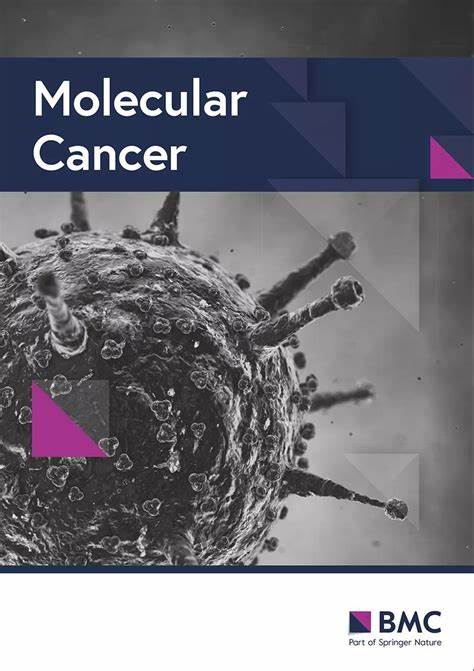揭开cGAS-STING通路的神秘面纱:肿瘤免疫微环境的精准调控
IF 33.9
1区 医学
Q1 BIOCHEMISTRY & MOLECULAR BIOLOGY
引用次数: 0
摘要
环GMP-AMP合成酶(cGAS)-干扰素基因刺激因子(STING)信号通路作为细胞质DNA的免疫前哨,识别来自异常定位的核DNA或线粒体DNA (mtDNA)的双链DNA (dsDNA),在先天免疫应答和肿瘤免疫监测中起关键作用。常规抗肿瘤治疗诱导基因组不稳定和线粒体应激,导致核DNA和mtDNA释放到细胞质中,从而激活cGAS-STING途径。这种激活触发I型干扰素(IFN-I)和促炎细胞因子的产生,重塑肿瘤免疫微环境(TIME)。然而,TIME的复杂性揭示了cGAS-STING信号的“双刃剑”效应:在激活抗肿瘤免疫应答的同时,也通过调节免疫抑制细胞和基质成分促进免疫逃逸和转移。这篇综述全面描述了TIME成分通路的不同调控机制,强调了其在肿瘤免疫中的多方面作用。此外,本文还综述了针对cGAS-STING通路的肿瘤免疫治疗的最新进展和挑战,旨在推进cGAS-STING信号调节作为抗肿瘤治疗中重编程时间和克服免疫抑制的关键治疗策略。本文章由计算机程序翻译,如有差异,请以英文原文为准。
Demystifying the cGAS-STING pathway: precision regulation in the tumor immune microenvironment
The cyclic GMP-AMP synthase (cGAS)-stimulator of interferon genes (STING) signaling pathway serves as an immune sentinel for cytosolic DNA, recognizing double-stranded DNA (dsDNA) derived from abnormally localized nuclear DNA or mitochondrial DNA (mtDNA), and plays a pivotal role in innate immune responses and tumor immune surveillance. Conventional antitumor therapies induce genomic instability and mitochondrial stress, leading to the release of nuclear DNA and mtDNA into the cytosol, thereby activating the cGAS-STING pathway. This activation triggers the production of type I interferons (IFN-I) and pro-inflammatory cytokines, which reshape the tumor immune microenvironment (TIME). However, the complexity of TIME reveals a “double-edged sword” effect of cGAS-STING signaling: while it activates antitumor immune responses, it also promotes immune escape and metastasis through the regulation of immunosuppressive cells and stromal components. This review comprehensively delineates the differential regulatory mechanisms of the pathway within TIME constituents, highlighting its multifaceted roles in tumor immunity. Furthermore, it reviews recent advances and challenges in targeting the cGAS-STING pathway for cancer immunotherapy, with the aim of advancing cGAS-STING signaling modulation as a key therapeutic strategy to reprogram TIME and overcome immunosuppression in antitumor treatment.
求助全文
通过发布文献求助,成功后即可免费获取论文全文。
去求助
来源期刊

Molecular Cancer
医学-生化与分子生物学
CiteScore
54.90
自引率
2.70%
发文量
224
审稿时长
2 months
期刊介绍:
Molecular Cancer is a platform that encourages the exchange of ideas and discoveries in the field of cancer research, particularly focusing on the molecular aspects. Our goal is to facilitate discussions and provide insights into various areas of cancer and related biomedical science. We welcome articles from basic, translational, and clinical research that contribute to the advancement of understanding, prevention, diagnosis, and treatment of cancer.
The scope of topics covered in Molecular Cancer is diverse and inclusive. These include, but are not limited to, cell and tumor biology, angiogenesis, utilizing animal models, understanding metastasis, exploring cancer antigens and the immune response, investigating cellular signaling and molecular biology, examining epidemiology, genetic and molecular profiling of cancer, identifying molecular targets, studying cancer stem cells, exploring DNA damage and repair mechanisms, analyzing cell cycle regulation, investigating apoptosis, exploring molecular virology, and evaluating vaccine and antibody-based cancer therapies.
Molecular Cancer serves as an important platform for sharing exciting discoveries in cancer-related research. It offers an unparalleled opportunity to communicate information to both specialists and the general public. The online presence of Molecular Cancer enables immediate publication of accepted articles and facilitates the presentation of large datasets and supplementary information. This ensures that new research is efficiently and rapidly disseminated to the scientific community.
 求助内容:
求助内容: 应助结果提醒方式:
应助结果提醒方式:


